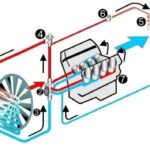Slide 1. Introduction.
The class develops what predictive maintenance is, how to avoid serious breakdowns, and the implications for fleet management.
Slide 2. Predictive maintenance.
- What is predictive maintenance?.
Vehicle maintenance is essential to ensure performance and driving safety. Among the most advanced strategies is predictive maintenance, which combines technology and data analysis to optimize vehicle condition and prevent unexpected failures.
Predictive maintenance uses sensors and technological tools to monitor vehicle condition in real time. These devices collect information on the performance of key components, such as the engine, brakes, or suspension, and allow anomalies to be identified before they become serious problems.
Thanks to this data, repairs can be planned strategically, vehicle downtime reduced, and unexpected breakdowns avoided.
For example, a sensor that monitors oil condition can alert you to the need for an oil change before the engine is damaged.
- Advantages of predictive maintenance.
Predictive maintenance has multiple advantages for fleet management.
- It reduces costs.
It allows you to predict breakdowns and failures before they turn into more expensive repairs or prolonged vehicle downtime.
- It reduces vehicle downtime.
Vehicle downtime is reduced because breakdowns or failures are anticipated before they occur.
- Anticipation of mechanical failures.
Detecting breakdowns and failures before they become serious not only avoids high repair costs, but also prevents accidents related to mechanical failures while driving.
- Resource optimization.
Predictive maintenance allows you to identify which components and systems require attention, thus avoiding the replacement of parts or spare parts that are still useful. It also optimizes the use of materials such as lubricants and spare parts.
- Extended vehicle life.
By addressing problems before they become serious, premature wear and tear on components and systems is reduced, and the vehicle remains in good condition for longer.
- Optimization of maintenance scheduling.
Instead of following fixed maintenance intervals, predictive maintenance allows interventions to be carried out only when necessary, saving time and preventing unnecessary vehicle downtime.
- Greater efficiency and sustainability.
Keeping vehicle components in proper condition reduces fuel consumption and pollutant emissions, improving vehicle performance and environmental impact.
- How predictive maintenance is performed.
The process consists of several stages:
- Installation of sensors.
Sensors are installed in strategic components of the car, such as the engine, suspension, and brakes, and measure parameters such as temperature, pressure, vibrations, and wear. Some of these sensors are already installed at the factory.
- Tools used.
The most common tools are vibration sensors, infrared thermometers, and OBD on-board diagnostic systems.
- Data collection.
The sensors collect information in real time and send it to a storage and analysis system.
- Analysis using artificial intelligence.
Algorithms process the data to identify patterns or anomalies that could indicate an imminent failure.
Artificial intelligence allows large volumes of data to be analyzed in real time.
- Predictive models.
Predictive models are essential tools in predictive maintenance. These models use historical and current data to predict the future behavior of vehicle components. Artificial intelligence increases the accuracy of these models, allowing technicians to make more informed and timely interventions.
For example, a model may predict that brake wear will increase by 20% over the next six months, allowing for replacement to be scheduled before it becomes a problem.
- Integration with fleet management systems.
Artificial intelligence also facilitates the integration of predictive maintenance into fleet management systems. This allows managers to monitor the status of multiple vehicles simultaneously and make decisions based on real-time data.
For example, if a vehicle shows signs of imminent failure, the system can automatically alert the fleet manager to schedule a service, thereby optimizing fleet operation.
- Alert generation.
The system issues notifications or detailed reports so that the fleet manager or workshop manager can take the necessary action before a breakdown occurs.
- Implementation of predictive maintenance.
- Needs assessment.
Before implementing a predictive maintenance system, it is essential to assess the specific needs of the fleet. This includes identifying critical components and systems that require constant monitoring and determining the resources needed for implementation.
For example, a freight vehicle may require a different approach than a passenger vehicle.
- Technology selection.
Choosing the right technology is critical to the success of predictive maintenance. This may involve selecting sensors, analytics software, and data management platforms. Such technology must be compatible with existing systems and capable of providing accurate, real-time data.
For example, integrating advanced sensors into the vehicle's OBD system can provide valuable information about engine performance.
- Staff training.
Staff training is a fundamental aspect of implementing predictive maintenance. Technicians must be familiar with the tools and technologies used, as well as data analysis procedures. This ensures that predictive maintenance is performed effectively and that informed decisions are made based on the data collected.
For example, a trained technician can correctly interpret sensor alerts and take appropriate action to prevent failures.
Slide 3. Challenges and future of predictive maintenance.
- Challenges in predictive maintenance.
- Initial costs.
One of the main challenges when adopting predictive maintenance is the initial costs associated with implementing advanced technology. The investment in sensors, software, and training can be considerable. However, in the long term, the savings in repair costs and increased efficiency can justify this investment.
- Data management.
Managing large volumes of data generated by predictive maintenance systems can be complex. Therefore, it is essential to have robust systems in place to store, process, and analyze this data efficiently. Lack of adequate infrastructure can limit the effectiveness of predictive maintenance.
For example, an inefficient data management system can cause delays in identifying problems.
- Resistance to change.
Resistance to change on the part of staff can be an obstacle to the implementation of predictive maintenance. It is essential to involve all levels of the organization in the change process and highlight the benefits of the new approach. To overcome this, effective communication and ongoing training are essential.
For example, showcasing success stories can motivate employees to adopt new technologies.
- The future of predictive maintenance in vehicles.
- Technological advances.
The future of predictive maintenance is linked to technological advances in artificial intelligence and data analysis. Artificial intelligence is expected to continue evolving and improve the accuracy of predictions and process automation.
For example, the implementation of more sophisticated algorithms will allow faults to be detected earlier.
- Connectivity and smart vehicles.
The growing connectivity of vehicles, through technologies such as the Internet of Things-IoT, will enable even more effective predictive maintenance. Vehicles will be able to communicate with each other and with infrastructure, providing real-time data that will improve decision-making.
For example, a vehicle could alert others to dangerous road conditions, which could influence preventive maintenance.
- Sustainability and efficiency
Predictive maintenance will also contribute to the sustainability of the automotive sector. By optimizing the use of resources and extending the life of vehicles, the environmental impact associated with their production and disposal will be reduced.
For example, a proactive approach to maintenance can decrease the amount of waste generated by prematurely discarded parts.
- Implications for fleet management.
The main consequence is cost savings and vehicles being available for longer to provide the service.
Investing in predictive maintenance is a long-term strategic decision. Although it may require an initial investment to install sensors and analysis systems, the benefits far outweigh the costs.
There are already telematics companies on the market that offer predictive maintenance and integrate data storage and analysis systems, which significantly reduces the cost of use.
Workers who will be managing predictive maintenance must be trained to interpret the data results in order to achieve high performance.
Preventive maintenance of vehicles must be carried out according to the vehicle manufacturer's instructions, even if predictive maintenance is performed. If the component or system is in good condition or is not going to fail, the maintenance or replacement period for the component or system can be extended.
For example, when I was a fleet manager for the street cleaning service in Madrid, oil analysis was performed on the engines, and as the oil was in good condition, the oil change was extended from 30,000 kilometers to 45,000 kilometers in some vehicles.
In summary, predictive vehicle maintenance, powered by artificial intelligence, represents a significant evolution in maintenance management. Thanks to constant monitoring and data analysis, it is possible to anticipate failures and optimize vehicle performance, resulting in greater efficiency and safety. Although its implementation poses challenges, it offers tangible benefits that justify the investment.
Slide 4. Thank you for your time.
The class has developed what predictive maintenance is, how to avoid serious breakdowns, and the implications for fleet management, see you soon.
Download the audio




















